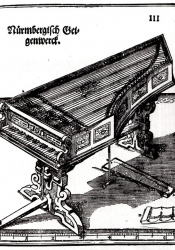Hans Heyden Creates the Geigenwerk
German engineer Hans Heyden creates the first working approximation of the viola organista, the Geigenwerk, paving the way for a category of instrument called the “sostenente piano,” signifying a keyboard instrument that produces a sustained sound (as opposed to the percussive voice of a concert piano). The Geigenwerk deviated significantly from the viola organista, but the primary concept behind both is very similar. The Geigenwerk had forty-four keys and five foot-pedals, used to activate the internal wheels that bowed the stings. The creation of this instrument allowed for the spirit of the viola organista to return to Italy, as a Medici prince would purchase a Geigenwerk in the sixteenth century.
Many German craftsmen begin to take da Vinci’s designs, along with the Geigenwerk, as inspiration for their own instruments. The clavichord, a common piano-esque instrument used for composing at the time, was too quiet for public performance and many designers wanted to broaden the available dynamic range as well. Variations of the sostenente piano would continue to be produced as one-off creations until roughly the nineteenth century.
Apel, W. L. (1969). Harvard Dictionary of Music. Cambridge, MA: Belknap Press of Harvard University Press.
Badura-Skoda, E. (2017). The Eighteenth-century Fortepiano Grand and Its Patrons: From Scarlatti to Beethoven. Bloomington: Indiana University Press.
Geigenwerk Praetorius [Digital image]. (2014, October 19). Retrieved from https://commons.wikimedia.org/wiki/File:Geigenwerk_Praetorius.jpg

